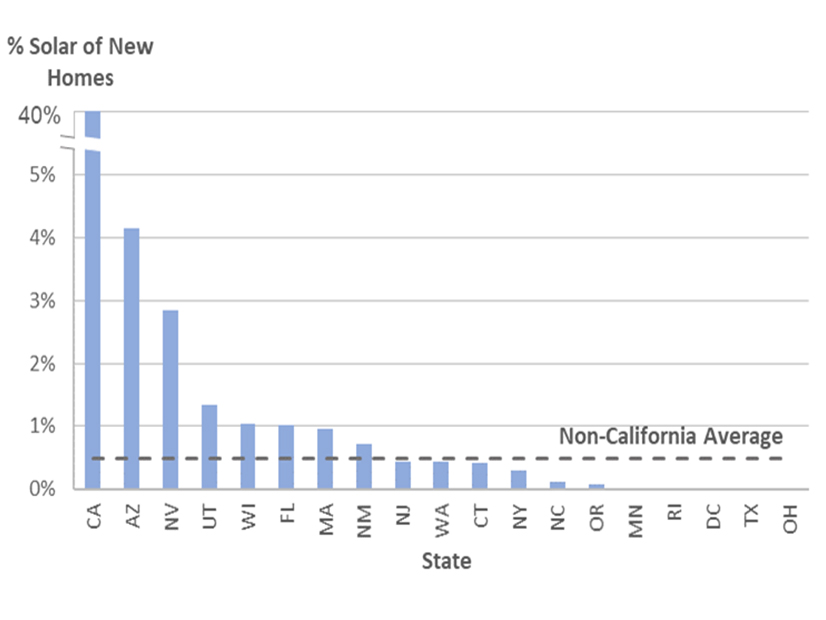A California incentive program may have helped boost the rate of solar installation in new homes in the state to 40% in 2019, well above the non-California national average of less than 1%, according to a new study.
Within California, the percentage of new homes with solar varied widely by region. Much higher deployment was seen within the territories of investor-owned utilities, Lawrence Berkeley National Laboratory researchers said in their new report, “Starting with Solar.” The study, by researchers Grace Brittan and Ben Hoen, was the subject of a webinar last week.
One potential reason for the regional differences is a solar incentive that was available to IOU customers.
The New Solar Homes Partnership (NSHP) program was launched by the California Energy Commission in 2007. The program accepted applications until April 2018 and issued payments through 2021.
The cash-rebate incentive for solar energy systems in new homes ranged from 50 cents to $1.25/watt. The incentive was available in the service territories of Pacific Gas and Electric, San Diego Gas & Electric and Southern California Edison.
“In investor-owned utility areas of the state where NSHP incentives were available, recent new solar home penetration rates were approximately 50%,” the researchers said. “Outside those IOU areas, penetrations were less than 5%.”
As part of their study, the researchers talked to building industry representatives.
“[We] take advantage of the regulatory environment in each state,” said one large builder, who was not identified. “Net metering and other incentives are central to new solar homes penciling out.”
In contrast to the NSHP incentive, net metering is offered both inside and outside of IOU territories, Hoen noted.
The NSHP program preceded California’s solar mandate for new homes. The CEC approved the mandate in 2018, and it took effect on Jan. 1, 2020.
Regional Differences
In contrast to the new-home solar deployment rate of 40% in California, the rate in the U.S. outside of California was about 0.5% in 2018/19, the study found.
But some areas did better than others. The rate of new-home solar was just over 4% in Arizona, nearly 3% in Nevada and about 1.3% in Utah.
In Las Vegas, three zip codes made the top 10 list for new-home solar deployment outside of California, with rates of 79%, 50% and 24%. Bellingham, Wash., also made the top 10, where 25 out of 114 new homes were equipped with solar, or 22%.
Within California, new-home solar deployment in 2018/19 was highest in three counties — Placer, El Dorado and Yolo — where it hit 70%.
The Berkeley Lab study compared solar systems on new homes in California versus existing homes. The size of systems installed on existing homes in the state has been gradually increasing, to about 7 kW in 2020. In contrast, system size on new homes has been relatively flat from 2015 to 2020, around 4 kW.
“While new homes generally have smaller system sizes than existing homes, this may be due to having more energy-efficiency measures (less load),” the researchers said.
Builder Differences
From 2018 to 2020, about 7% of solar installations on existing homes in California included battery systems. In contrast, less than 1% of new-home solar systems came with batteries, the study found.
The researchers also looked at solar deployment among home builders who had the largest market share in California. Some, but not all, of the top new home builders had high rates of solar-equipped homes.
For Lennar, which had about 10% of the market share in 2018/19, around 90% of new homes in IOU territories were solar-equipped. Woodside Homes, with about 3% of the market share, was also close to 90% solar deployment in IOU territories.
The researchers noted that Lennar installed the solar systems themselves, while other builders subcontracted solar installation.
The NSHP program goal was the installation of 360 MW of solar energy capacity on new housing by the end of 2021. According to the program’s final report, $241 million in incentives were paid through the program for the installation of 232 MW of solar energy capacity.
About 12% of the total incentive payments went to affordable housing projects, which had a total capacity of 22 MW.
The CEC report noted that the program began with large incentive rates that were gradually reduced as hardware costs dropped over time. The installation of solar on new homes “is now cost effective without additional incentive money,” the report said.
CEC called the NSHP program a success.
“The NSHP program furthered the transition to a clean energy economy and has served as a model for new renewable and energy efficiency incentive programs across the United States,” CEC said in the report.
